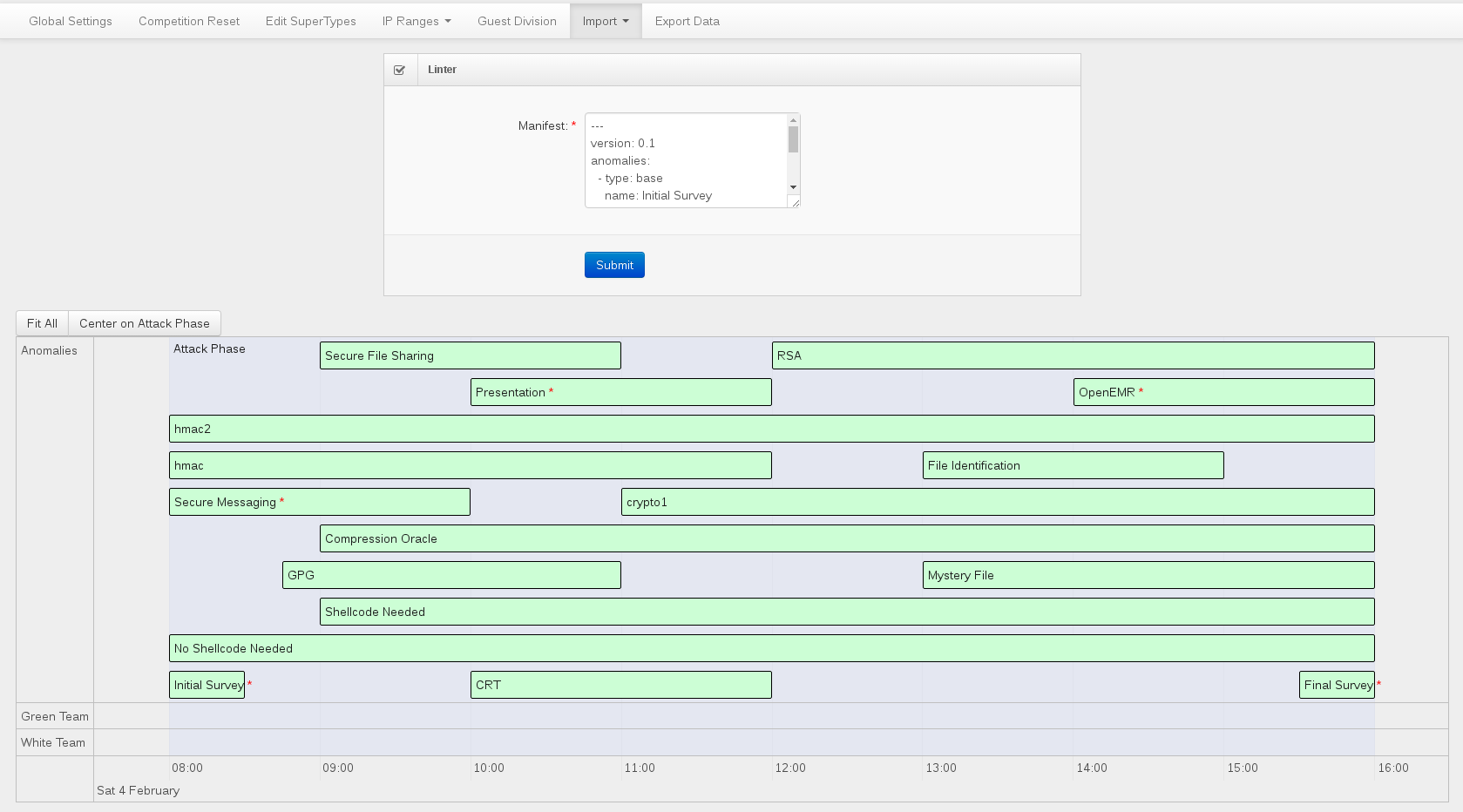CDC Data Manifest Format
Manifest files are written in YAML and need to be in a file called manifest.yml.
File Format
All dates must be in the format YYYY-MM-DD HH:mm in order for IScorE to parse them correctly. While it may be able
to parse other formats, this format is the expected one that is guaranteed to work. There should always be a top-level
key version that declares what manifest format is being used by the file. The current manifest version is 0.1.
Linter
You can check your manifest by copying and pasting it into the manifest linter. The manifest linter can be found under the Admin Area in Competition Settings. If the manifest is invalid, the linter display an error message explaining what is wrong. If the manifest is valid, the linter will render a timeline (shown below) of the events in the manifest.

Anomalies
A basic manifest that defines an Initial Survey anomaly can be written as:
---
version: 0.1
anomalies:
- type: base
name: Initial Survey
opens: 2016-04-10 08:00
closes: 2016-04-10 16:00
max_score: 5
All manifest files may have a top level anomalies list. Each item in the anomalies list is a dictionary that
describes the anomaly.
typeWhat kind of anomaly is this? Can be one of
base,task,ctf.nameThe name of the anomaly; this is what will be displayed to the user.
dirThe directory containing information about the anomaly. Defaults to a slug of the anomaly name.
opensWhat time the anomaly should be available.
closesWhat time the anomaly expires.
max_scoreThe score for the anomaly
required(default False)This is a boolean that determines whether the anomaly is required or not.
file(optional)This can either be a filename, or a list of file names that should be zipped an attached to the anomaly.
description(optional)Can either be the filename of a markdown file describing the anomaly, inline markdown, or left out entirely. If left out, the default of
description.mdwill be used.grading(optional)Can either be the filename of a markdown file describing the grading of the anomaly, inline markdown, or left out entirely. If left out, the default of
grading.mdwill be used.
Note
All parameters involving files are relative to the anomalies directory. If dir is not provided, this will be the
slug of the anomaly’s name.
CTF Anomalies
Anomalies of type ctf also have the following parameters:
released(default True)Whether the score for this anomaly should be released. This is useful for teams to get points immediately upon submitting the correct flag.
Usability Checks
A basic manifest that defines a Morning Usability Check can be written as:
---
version: 0.1
usability:
lists:
- name: Morning Check
sections:
- name: www.teamN.iserink.com
order: 1
link: www.team{num}.isucdc.com
items:
- name: Log In
type: boolean
score: 1
order: 1
- name: Do Stuff
type: int
score: 5
order: 2
- name: shell.teamN.iserink.com
order: 1
items:
- name: Do stuff as admin
type: boolean
score: 5
order: 1
checks:
- name: "9:00 Usability Check"
list: Morning Check
start_time: 2016-04-10 09:00
end_time: 2016-04-10 16:00
max_score: 25
All manifest files may have a top level usability dictionary. The usability directory MUST have the
following keys: lists and checks. The lists key is a list of dictionaries describing a usability checklist.
The checks key is a list of dictionaries describing a usability check.
lists
nameThe name of the Check List.
sectionsA list of usability check sections.
nameThe name of the section.
orderThe order this list is shown to the user in.
link(optional)A url that will be displayed to green team when performing the check. Provides the
{num}format variable.itemsA list of usability checklist items.
nameThe name of the checklist item.
typeThe type of the item. Can be
integerorboolean.scoreThe maximum score for the item.
orderThe order the item is displayed to the user.
checks
nameThe name of the usability check.
listThe name of the checklist to use. This MUST match the name of a Check List.
start_timeThe time the check starts.
end_timeThe time the check ends.
max_scoreThe maximum possible score for the check.